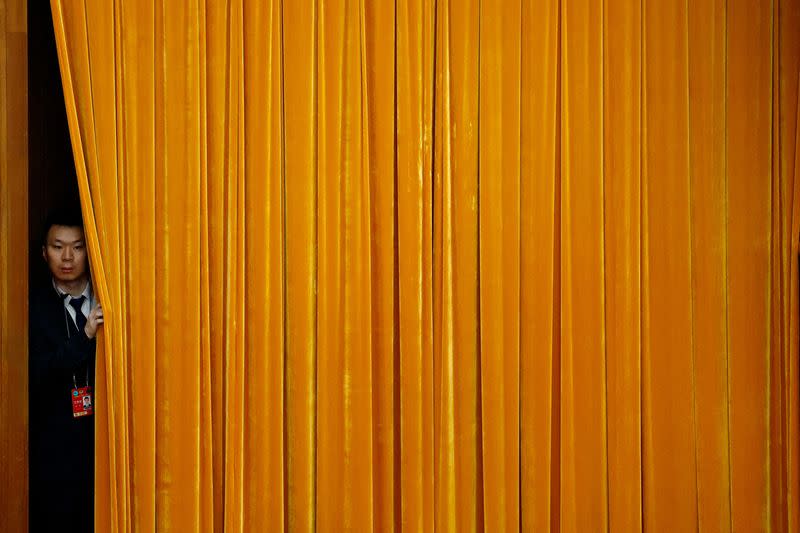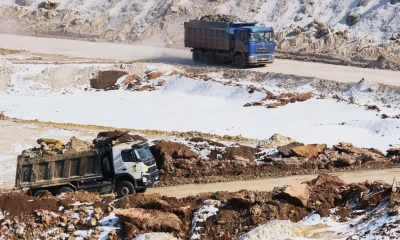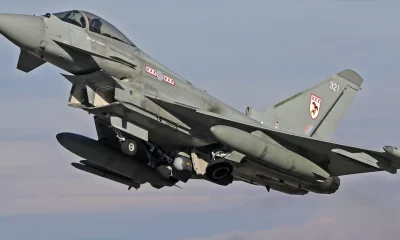Analysis
Russia’s Silent Storm Sweeps East Africa

While the West obsesses over China and the Middle East boils with conflict, Russia has been quietly weaving itself into the geopolitical fabric of East Africa. From Port Sudan to Kampala, Moscow is laying down roots—military, economic, and diplomatic—as part of a sweeping strategy to reassert its global clout. And make no mistake: the Kremlin’s new African chapter is not just about influence. It’s about power.
When Russian Foreign Minister Sergei Lavrov addressed the State Duma earlier this year, he made it clear: Africa is no longer an afterthought. It’s a priority. This isn’t nostalgia for Cold War alliances with Ethiopia and Somalia. It’s a modern campaign to outmaneuver both China and the US in a continent increasingly tired of Western hypocrisy.

Source: Russian Ministry of Foreign Affairs
The flashpoint? Port Sudan. Russia’s long-awaited naval base deal is now official, granting Moscow unprecedented access to the Red Sea—a chokepoint that links the Suez Canal to the Indian Ocean. With this single move, Russia just altered the naval calculus for every global power operating in the region.
But the strategy doesn’t end there. Russian troops are already stationed in Burkina Faso and Mali, propping up military-led regimes that have openly defied French and American influence. Moscow is positioning itself as the preferred partner for Africa’s new strongmen—a relationship built on arms, sovereignty, and mutual disdain for the West’s patronizing tone.
Now, embassies are popping up across the map: South Sudan, Comoros, Togo, Liberia. Lavrov isn’t just cutting ribbons. He’s laying the foundation of a new diplomatic offensive that will rival anything Brussels or Washington can match.
And here’s the kicker: Russia is using African labor to build weapons of war. In Tatarstan, thousands of Ugandan women are assembling Shahed drones for deployment in Ukraine’s killing fields. It’s a deeply controversial program now under Interpol investigation, but it underscores how deep the Kremlin’s roots are growing in African soil.
This is not just about trade, though that too is booming. Russian-African commerce hit $18.6 billion in 2024, led by agricultural exports to Egypt. Russian universities are flooded with African students, particularly in agronomy, as the Kremlin reinvests in soft power tools long neglected.
WARYATV’s assessment: Africa’s center of gravity is shifting. As the West debates sanctions and democracy, Moscow is quietly executing a full-spectrum strategy that combines economic allure, military protection, and diplomatic respect. In East Africa—and perhaps beyond—Russia isn’t just back. It’s planting flags.
Analysis
CIA’s New Offensive Targets Chinese Elites Through Psychological Warfare

The U.S. is now openly hunting for CCP insiders, and the battlefield is your smartphone.
The CIA is no longer hiding its intentions — new Chinese-language videos aim to recruit Communist Party defectors. What does this bold move signal about the U.S.-China shadow war, and why it matters to Africa and the Middle East?
In a stunning escalation of psychological warfare, the CIA has dropped a pair of slick Chinese-language recruitment videos — not in secrecy, but in full global view. Posted to the agency’s public channels, the videos invite disillusioned Chinese Communist Party insiders to defect and leak secrets to the U.S. — and they’re already getting through China’s Great Firewall.
This isn’t Cold War cloak-and-dagger. It’s digital-age subversion, broadcasted like an ad campaign.
The videos depict fictional but plausible narratives: a senior CCP official and a low-ranking bureaucrat both awaken to the paranoia and disposability within Xi Jinping’s regime. They use secure communication to reach the CIA — and the message is clear: “We’re waiting.”
U.S. officials claim the campaign is working. “If it weren’t working, we wouldn’t be making more videos,” one CIA insider told Reuters. These are not just passive efforts to observe China’s ascent — they’re active operations meant to pierce the inner sanctum of Beijing’s ruling elite.
But why now?
Beijing is undergoing massive internal purges. Top generals, business moguls, and political stars are vanishing under Xi’s iron grip. The CIA sees an opening — a growing pool of embittered, frightened, and ambitious insiders with everything to gain by switching sides.
The CIA isn’t just seeking leaks on espionage or party politics — they want advanced tech secrets, economic war intel, and battlefield doctrines. They’re mining for gold at the heart of China’s global rise.
This move could reshape the next decade of U.S.-China hostilities. And the implications extend far beyond Asia.
Why Africa and the Middle East should care:
This campaign shows Washington’s strategy is no longer reactive. It’s preemptive, disruptive, and unashamed. If the CIA is hunting Chinese insiders, expect new fronts in cyberwarfare, proxy diplomacy, and AI tech espionage to erupt in regions like East Africa, the Red Sea, and the Gulf — where China and the U.S. are already locked in soft-power duels.
Bottom line:
The CIA just made spycraft viral. Beijing is watching nervously. Africa and the Middle East would be wise to do the same.

Analysis
Ukraine’s Minerals for Security? Washington Strikes Strategic Ground in Kyiv

The imminent signing of a long-awaited minerals agreement between the United States and Ukraine marks a pivotal shift in how Washington approaches its support for Kyiv—moving from traditional aid packages to strategic economic entrenchment.
While publicly billed as an “investment partnership fund,” this deal goes beyond economics. It is a calculated geopolitical maneuver by the Trump administration to secure critical resources, reframe transatlantic burden-sharing, and deepen U.S. commercial stakes in Ukraine’s future—all while subtly shifting the cost of war.
At the heart of the agreement is access to Ukraine’s vast untapped reserves of rare earth elements and strategic minerals—22 of the 50 identified by the U.S. Geological Survey as vital to national security. These include inputs essential for advanced electronics, military systems, and clean energy technologies. For the U.S., securing these resources is a direct hedge against China’s dominance in the global critical minerals market.
For Ukraine, however, this is more than a mining deal—it is an existential gamble. Having previously balked at Trump’s demand to “sign first, guarantee later,” President Zelensky’s administration now appears to have recalibrated. The presence of U.S. investment and corporations on Ukrainian soil is seen as a de facto security layer—one that would make future abandonment by Washington more politically costly.
That shift in strategy speaks volumes. Ukrainian officials now see economic entanglement as their best insurance policy. In return, the U.S. gains strategic supply chain diversification and positions itself as Kyiv’s key post-war development partner—without making formal security guarantees.
This deal also sends a message to Europe. After the February Oval Office fallout and aid freeze, EU nations pledged to step up support, sensing growing unpredictability in U.S. foreign policy. Now, with Washington reentering through the minerals door, Brussels may need to rethink its role in Ukraine’s reconstruction and resource exploitation.
The fine print of the agreement remains under wraps, but the framing is clear: this is not a gift—it’s a partnership with a price. Trump’s doctrine of transactional diplomacy is alive and well, and Ukraine, caught between survival and sovereignty, is adapting to the new rules.
Analysis
Operation Rough Rider Escalates as UK Joins Trump’s Military Campaign Against Houthis

The United Kingdom’s latest joint airstrike with the United States marks a new phase in the ongoing campaign against Yemen’s Houthi rebels—one that reveals both the deepening of transatlantic military coordination and the mounting complexity of Red Sea security.
On Tuesday night, British Typhoon fighter jets, in coordination with US forces, targeted a cluster of drone manufacturing sites south of Sanaa. The strikes were carried out with precision-guided bombs following extensive intelligence and planning. The Ministry of Defence in London emphasized that the mission was designed to minimize collateral damage, while sending a clear message of deterrence.
This strike—Britain’s first public acknowledgment of a joint operation since President Donald Trump launched Operation Rough Rider—signals a shift. It is no longer just about disruption of Houthi logistics, but about visible, sustained punishment of a group that has effectively paralyzed one of the world’s busiest maritime corridors. The Houthis’ attacks have caused a staggering 55% drop in shipping through the Red Sea, according to UK Defense Secretary John Healey, with economic repercussions felt far beyond the Gulf.
Since Trump initiated the campaign in March, over 800 US strikes have hammered Houthi infrastructure, including refineries, airports, missile depots, and now drone labs. Yet the results remain mixed. While dozens of senior Houthi officers are reported killed, the group’s ability to intercept American drones and continue attacks on commercial vessels shows it remains operationally resilient.
The UK’s renewed participation adds credibility to the broader Western coalition’s resolve—but it also increases the risks of mission creep, civilian casualties, and regional blowback. Already, allegations are surfacing. Just this week, the Houthis claimed that a US strike killed at least 68 African migrants held in a detention facility—an allegation now under investigation by CENTCOM.
What emerges is a complicated battlefield: Trump is pursuing a hard-power strategy to restore deterrence and freedom of navigation, but his campaign is being tested by asymmetric warfare, Iranian proxy dynamics, and humanitarian optics.
As the Red Sea becomes increasingly militarized, the question looms: Will these strikes produce strategic deterrence, or draw the West deeper into a conflict that cannot be won from the air alone?
Analysis
Somalia’s Airspace Ban Reveals China’s Grip—and Somaliland’s Rising Global Standing

The Somali government’s latest directive banning entry to Taiwanese passport holders is more than a travel restriction—it’s a geopolitical message dictated from Beijing. In the guise of “UN compliance,” Mogadishu has escalated its hostility toward Somaliland and deepened its role as a regional surrogate for Chinese interests in the Horn of Africa.
Somaliland, unlike Somalia, has been a functioning democracy for over three decades. Its strategic and values-based partnership with Taiwan—cemented in 2020 with mutual representative offices—represents a rare model of cooperation between two self-governing, democratic entities facing isolation due to external political pressures. That model is precisely what threatens both Beijing and Mogadishu.
The so-called compliance with UN Resolution 2758 is a legal stretch. The resolution merely transferred the China seat at the UN to the People’s Republic of China—it says nothing about Taiwan’s sovereignty. This deliberate misreading, pushed aggressively by Beijing and now echoed by Somalia, is being used to block Taiwan’s global engagement—especially with democratic partners like Somaliland.
The real message here is that Somalia is attempting to weaponize airspace control over a territory it no longer governs. Since 1991, Somaliland has reasserted its independence, conducted peaceful elections, built credible institutions, and attracted legitimate diplomatic interest from global partners like Taiwan, the UK, and the United States. That recognition is growing—and Somalia, under pressure from China, is reacting with desperate measures.
For Somaliland and its president, Abdirahman Mohamed Abdullahi Irro, this presents a strategic opportunity. The world is now watching Somalia’s China-backed aggression unfold in real time. This incident should trigger sharper diplomatic coordination between Somaliland and its allies. It underscores the urgent need for Somaliland to control its own airspace, protect its partners, and resist authoritarian overreach from both Mogadishu and Beijing.
If anything, this ban is proof that the Taiwan-Somaliland partnership is working—and rattling those who fear the emergence of new democratic alliances in East Africa. Somaliland’s measured, lawful, and values-driven diplomacy stands in stark contrast to Somalia’s politicized, externally manipulated retaliation.
The answer isn’t silence—it’s greater visibility. Somaliland and Taiwan must continue to demonstrate what cooperation between free nations looks like. And democratic states across Africa and beyond must decide: Will they stand with authoritarian pressure—or with those who are building real governance from the ground up?
Analysis
New Power Struggles in the Horn: Egypt and Russia Redraw the Map

Two major diplomatic events have unfolded in the Horn of Africa within the past week: The state meeting between Djibouti’s President Ismail Omar Guelleh and Egyptian President Abdel Fattah El-Sisi. The official visit of Russian Deputy Foreign Minister Mikhail Bogdanov to Somalia.
Intelligence Analysis Report
Both events signal significant recalibrations of regional alignments, with direct implications for maritime security, foreign military presence, and great-power competition.
The Horn of Africa has recently witnessed two notable diplomatic engagements that underscore the evolving geopolitical landscape in the region. These include the high-level meeting between Djibouti’s President Ismail Omar Guelleh and Egypt’s President Abdel Fattah El-Sisi in Djibouti, as well as the visit by Russia’s Deputy Foreign Minister Mikhail Bogdanov to Somalia on April 26, 2025.
Djibouti’s strengthening ties with Egypt reflect a broader strategic shift. As a host to key international military installations and a vital maritime logistics hub, Djibouti’s alignment with Egypt suggests a shared interest in enhancing regional maritime security and counterterrorism cooperation in the Red Sea and Gulf of Aden. Economic dimensions are also at play, with potential for expanded trade and investment. Egypt’s move to deepen relations with Djibouti appears aimed at countering the growing influence of Turkey, China, and Ethiopia in the region.
Conversely, Russia’s diplomatic overture in Somalia points to Moscow’s ambition to expand its footprint in the Horn of Africa. Bogdanov’s visit signals potential discussions around military cooperation, arms deals, and support for Somalia’s security infrastructure. Russia’s engagement may also be interpreted as an attempt to challenge Western dominance in the area, particularly that of the United States and European Union. In addition to geopolitical considerations, Somalia’s untapped natural resources, including possible hydrocarbon reserves, add an economic incentive to Russia’s interest.
Together, these developments reflect an intensifying competition among global powers for influence in the Horn of Africa. Djibouti’s strategic positioning and Somalia’s emerging partnerships are reshaping alliances and security arrangements. The growing involvement of Egypt and Russia suggests that the Horn will continue to serve as a critical arena for geopolitical maneuvering, with significant implications for regional stability and global power dynamics.
Ongoing monitoring and strategic foresight will be essential to gauge the long-term consequences of these diplomatic movements and their impact on the balance of power in the region.
Analysis
India Prepares for a Spectacular Strike on Pakistan

Diplomatic leaks reveal India is not seeking peace talks — it’s building the case for decisive military action against Pakistan.
India Prepares for War: Building the Case for a Spectacular Strike on Pakistan
The world may soon witness the most dangerous India-Pakistan military escalation in years — and this time, New Delhi is making no apologies.
In the days since a horrific terrorist attack in Kashmir left 26 civilians dead, Indian Prime Minister Narendra Modi has moved swiftly, briefing over 100 foreign diplomats and personally speaking to more than a dozen world leaders.
But the message has been clear:
This is not a call for restraint. It’s a warning. India is preparing to strike.
Without explicitly naming Pakistan, Modi has vowed “severe punishment” and promised to raze “terror safe havens.” Indian officials, behind closed doors, have repeatedly linked the attack to Pakistan’s longstanding support for jihadist groups operating in Kashmir.
The technical evidence remains murky — facial recognition data, patterns of past attacks — but in the chaos of today’s fractured world order, India feels emboldened.
No major power is stepping in to urge caution.
A World Distracted — A Window for Action
The United Nations and European Union have issued the usual platitudes for dialogue. Iran’s foreign minister has offered to mediate.
But the United States, locked in internal crises and foreign wars, has voiced only muted support for India’s pursuit of “justice.”
There is no ambassador in New Delhi.
There is no active diplomatic intervention.
And there is no real restraint.
If anything, India reads the global silence — especially from Washington — as a green light.
Modi’s Playbook: Hit First, Talk Later
Analysts warn that Modi’s administration, learning from the 2019 Balakot incident, will not settle for a symbolic airstrike this time.
India is aiming for something spectacular — a strike that would inflict real political and military cost on Pakistan.
But the risks are enormous.
Pakistan’s military, already rattled by internal instability, has vowed to retaliate with force that would “match and exceed” any Indian move.
Both nations are nuclear-armed.
Both leaders are politically invested in appearing strong.
The tit-for-tat cycle could spiral faster than in any previous confrontation.
Is Escalation Inevitable?
Unlike 2019, when responsibility for the terrorist attack was clear, this time claims of responsibility are murky.
A shadowy group called the “Resistance Front” emerged online — a name Indian officials privately link to Lashkar-e-Taiba, the Pakistani-based terrorist network.
But formal evidence tying Pakistan’s government to the latest atrocity remains thin.
For India, the justification is simpler:
Pakistan’s hands are already stained with decades of bloodshed in Kashmir.
Diplomats privately admit New Delhi’s case relies more on historic patterns than hard proof this time — a strategy fraught with risk.
Yet for Modi, the political stakes are clear:
After striking back in 2016 and 2019, doing nothing now would be seen as weakness.
The Clock Is Ticking
India and Pakistan’s “managed hostility” — as some call it — may survive another clash.
Or it may spiral into a regional catastrophe.
Either way, the countdown has begun.
And this time, the world may be too distracted to stop it.
WARYATV will monitor this unfolding storm hour by hour.
Analysis
Kenya Falls Deeper Into China’s Orbit – Signing 20 Deals

China and Kenya elevate ties, signing 20 deals to deepen Belt and Road control and boost Beijing’s influence across Africa.
China Tightens Grip on Kenya as Xi and Ruto Forge “New Era” Alliance
While the world grapples with Beijing’s expanding shadow, Kenya just tightened the noose willingly.
On Thursday, Chinese President Xi Jinping and Kenyan President William Ruto agreed to elevate bilateral ties to what they proudly call a “China-Kenya community with a shared future for the new era” — a thinly veiled move to deepen Kenya’s dependency on Chinese power structures while boosting China’s control over Africa’s strategic corridors.
Xi wasted no time framing the deal in sweeping, imperial language: vowing to make Kenya an “example” of the China-Africa model, strengthen Belt and Road entrenchment, and lead the so-called “Global South” under China’s guidance. The symbolism couldn’t be clearer — Beijing isn’t just building roads anymore. It’s building regimes.
Under the agreement, the two leaders signed 20 new cooperation deals, expanding China’s reach into Kenyan high-tech sectors, infrastructure, education, tourism, media, and “people-to-people” propaganda networks. It’s a full-spectrum offensive designed to lock Kenya tighter into China’s long-term geopolitical designs.
In case the world had any doubts, Ruto declared Kenya’s full loyalty to Beijing’s agenda, reaffirming the “One China” policy and explicitly rejecting Taiwan’s sovereignty — echoing the exact rhetoric Beijing demands from its vassal states.
The timing is no accident. As trade wars escalate and the U.S. and its allies work to push back against China’s economic warfare, Xi is fast-tracking African dependencies. Kenya, once seen as a potential balancing actor, now looks poised to become a flagship outpost for Beijing’s economic empire on the African continent.
In exchange for railroads like the Mombasa-Nairobi line — now loaded with Chinese debt — Ruto has effectively offered up Kenya’s strategic autonomy. At the Great Hall of the People, Xi and Ruto celebrated the expansion of Belt and Road domination with grand ceremonies and banquet feasts, but behind the gold drapes lies a darker reality: Africa’s critical corridors are slipping into Chinese control without a fight.
Xi openly called for deeper financial “integration,” code for binding Kenya to Chinese lenders and markets, and painted Kenya as a “stabilizer” to help China challenge international trade norms set by the West. Ruto played along, warning against “trade wars” while applauding China’s global role as a “stabilizer” — a statement that echoes Xi’s anti-Western narrative almost word for word.
For Kenya, the price of loyalty may soon become clear: crushing debts, political capture, and a slow erosion of real sovereignty under Beijing’s careful hand.
For Africa — and the world — this is a powerful wake-up call.
As China cements its hold on yet another key African partner, the stakes are rising. Fast.
Analysis
The Rise of Russia’s African Empire: Moscow’s March to the Atlantic

As the U.S. disengages, Russia entrenches itself in Africa — arming juntas, toppling Western influence, and redrawing the global map.
Russia isn’t just playing defense on Ukraine—it’s building an empire in Africa. From the Sahel to the Atlantic coast, Moscow is turning instability into strategy. What the West sees as chaos, the Kremlin sees as opportunity. And it’s capitalizing fast.
The Trump administration’s focus on Eastern Europe has left Africa dangerously exposed. While the U.S. exits Niger and France retreats from Mali, Burkina Faso, and Senegal, Russia is stepping in—with weapons, mercenaries, and deals. And make no mistake: this isn’t charity. This is conquest by proxy.
In Burkina Faso, Mali, and Niger—the heart of the new Alliance of Sahel States—military juntas backed by Moscow have severed ties with France and the U.S., forming a regional force under Russian guidance. With 5,000 troops poised to reshape the Sahel, Western-backed frameworks like G5 Sahel are being dismantled. In their place? Russian-dominated command centers and Wagner-led operations.
Wagner PMC, far from being a rogue outfit, is the Kremlin’s hand in Africa’s affairs. From diamond mines in the Central African Republic to military bases in Libya, it embeds deeply, restructures loyalties, and leaves Moscow with leverage. In many African capitals, Wagner is more influential than any ambassador.
But Putin’s ambitions don’t stop at the Sahel. Lavrov’s 2023 visit to Mauritania, a key Atlantic state, signals a coastal pivot. Russia wants the Atlantic flank—naval access, trade routes, and digital infrastructure. And it’s using soft power, narratives of anti-colonial solidarity, and military dependence to get there.
Washington is watching—but not reacting. As Trump pursues a Ukraine deal with Putin, the Kremlin is racking up wins in Africa. China and Iran are also in sync, forming a trilateral axis to counter Western influence in every sphere—military, digital, and ideological.
Bottom line: Africa is no longer a battlefield for hearts and minds—it’s now a staging ground for great power competition. Russia isn’t just back. It’s building a new empire, and if the U.S. doesn’t act, NATO will find its southern flank compromised not by bullets, but by silence.
-

 Analysis2 months ago
Analysis2 months agoSaudi Arabia’s Billion-Dollar Bid for Eritrea’s Assab Port
-

 ASSESSMENTS1 month ago
ASSESSMENTS1 month agoOperation Geel Exposes the Truth: International Community’s Reluctance to Embrace Somaliland as a Strategic Ally
-

 Somaliland3 months ago
Somaliland3 months agoSomaliland and UAE Elevate Ties to Comprehensive Strategic Partnership
-

 Africa1 year ago
Africa1 year agoHow Somaliland Could Lead the Global Camel Milk Industry
-

 Analysis1 year ago
Analysis1 year agoIran escalates conflict, attacking Israel; US forces help Israel to intercept Iranian projectiles
-

 Analysis2 weeks ago
Analysis2 weeks agoFrom Cell to Summit: The Prisoner Who Became Syria’s President
-

 Top stories11 months ago
Top stories11 months agoGunmen Kill 11 in Southeastern Nigeria Attack, Army Reports
-

 Analysis1 year ago
Analysis1 year agoIsrael and Iran on Edge: Tensions Escalate Amidst Rising Threats































